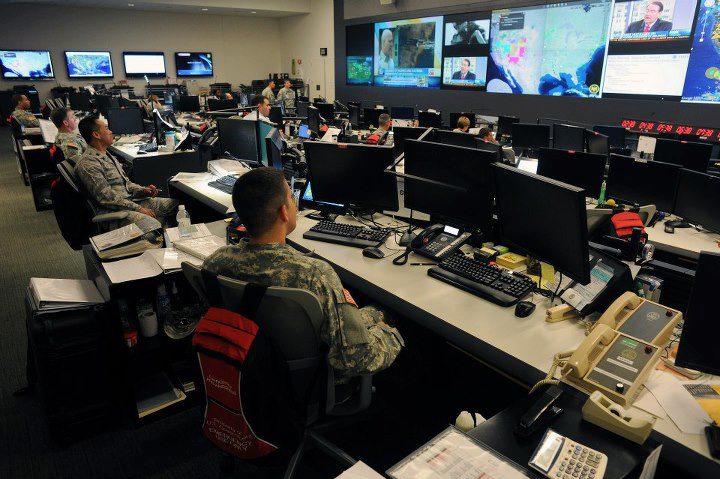
This is historical material “frozen in time”. The website is no longer updated and links to external websites and some internal pages may not work.
Summary:
As Isaac continues moving north, federal emergency personnel are still monitoring its progress and mobilizing to provide relief for those in its path.
This morning, Hurricane Isaac was downgraded to a tropical storm, and by the end of the day, it's expected to further diminish to a tropical depression.
But as the storm continues moving north, federal emergency personnel are still monitoring its progress and mobilizing to provide relief for those in its path.
In the past 24 hours, federal officials have taken the following steps to respond Isaac. Check out the list, compiled by the Federal Emergency Management Agency below, or visit FEMA.gov for additional information.
- The President was briefed by DHS Secretary Napolitano, FEMA Administrator Fugate and National Hurricane Center Director Dr. Knabb on the current impact of the hurricanes and federal government response and recovery actions.
- President Obama, joined by Department of Homeland Security (DHS) Secretary Janet Napolitano, FEMA Administrator Craig Fugate and National Hurricane Center Director Dr. Rick Knabb, convened a call with Alabama Governor Robert Bentley, Louisiana Governor Bobby Jindal, Mississippi Governor Phil Bryant, and New Orleans Mayor Mitch Landrieu. Secretary Napolitano also called Arkansas Governor Mike Beebe and Missouri Governor Jay Nixon to talk with them about preparations ahead of the arrival of Isaac and to offer any support they might need.
- FEMA Administrator Craig Fugate was on the ground in Louisiana, where he visited the state emergency operations center in Baton Rouge, met with Governor Bobby Jindal and Plaquemines Parish President Billy Nungesser.
- Secretary Napolitano also called Arkansas Governor Mike Beebe and Missouri Governor Jay Nixon to talk with them about preparations ahead of the arrival of Isaac and to offer any support they might need.
- FEMA Administrator Craig Fugate was on the ground in Louisiana, where he visited the state emergency operations center in Baton Rouge, met with Governor Bobby Jindal and Plaquemines Parish President Billy Nungesser.
- The Department of Energy is the designated Federal Sector-Specific agency directing Emergency Support Function12 (ESF-12) activities for the Energy Sector under the National Response Framework. DOE has teams of responders specializing in energy infrastructure and coordinating with deployed personnel, other Department offices, and Federal and State and local agencies in responding to the emergency.
- FEMA, in coordination with U.S. Northern Command deployed four UH-60 Blackhawk helicopters from Fort Campbell, KY and two SH-60 Seahawk helicopters from Norfolk Naval Air Station, VA, to assist in search and rescue efforts. A Search and Rescue planner has also been activated and deployed to the Baton Rouge Emergency Operations Center. There are four Emergency Planners Liaison Officers deployed to the National Response Coordination Center in support of FEMA and Fort Polk, LA has been designated as a Federal Team Staging Area. The command has activated Region VI Defense Coordinating Officer (DCO), and Defense Coordinating Element (DCE) to Baton Rouge, LA, to validate, plan and coordinate potential DOD support of FEMA's hurricane response operations and to facilitate DOD's support of potential life-saving and response operations.
- The U.S. Coast Guard will resume initial response activities aimed solely at saving or protecting lives, to include evacuating people from the affected area, as soon as weather permits, and will continue to monitor conditions at all impacted ports.
- The U.S. Army Corps of Engineers(USACE) continued to support the states of Alabama, Mississippi and Louisiana Emergency Operation Centers and FEMA Regions IV and VI Regional Response Coordination Centers to organize response efforts, has deployed Emergency Power Teams to Alabama, Mississippi and Louisiana. USACE's commodities, debris, and temporary roofing teams have deployed to Louisiana and others have been placed on alert status to support Florida, Alabama, and Mississippi. USACE teams also have been closely working with the State of Louisiana and Plaquemines Parish to assist in the flood fight of locally owned levees experiencing overtopping from Isaac. Teams on the ground are providing technical assistance, such as hydraulic modeling and finding available portable pumps, to reduce flooding.
- The American Red Cross (ARC) has provided shelter to more than 5,200 residents Tuesday night at about 80 shelters in six states from Florida to Texas as Hurricane Isaac made landfall along the Gulf Coast. Also, ARC deployed about 2,700 trained Red Cross disaster workers across the Gulf to run shelters, serve meals and distribute relief items. The Red Cross pre-positioned 311,000 ready-to-eat meals, kitchen support trailers and truck loads of relief supplies with clean up and personal hygiene items, cots, blankets, coolers, shovels, tarps and gloves. In addition, the Southern Baptist Convention had mobile kitchens capable of producing thousands of meals a day staged across the Gulf Coast alongside the Red Cross. Just outside the storm area, 187 emergency response vehicles were ready to move into affected communities as soon as weather conditions allow. Local shelter locations are available at http://www.redcross.org/find-help/shelter
- Mississippi National Guard responded to Hurricane Isaac with approximately 1,500 members from across the state including military police and others with civil support abilities that would enable them to assist local authorities in recovery and relief efforts. Guard members scouted potential sites for the distribution of food and water and established communications with the various local authorities.Louisiana National Guard pre-staged approximately 680 troops and assets across the New Orleans metropolitan area in order to better protect the community and its citizens as Hurricane Isaac churns toward the Gulf coast. In order to quickly respond to possible high-water evacuation or search and rescue missions, Soldiers from the 769th Engineer Battalion, 225th Engineer Brigade, staged Humvees hitched with boats at Jackson Barracks.
- USDA Farm Service Agency(FSA) urged livestock producers affected by natural disasters such as Hurricane Isaac to keep thorough records of their livestock and feed losses, including additional expenses for such things as feed purchases because of lost supplies.
- FEMA's Congressional Affairs Division hosted a Congressional Briefing via conference call in conjunction with NOAA's National Weather Service for the Alabama, Florida, Louisiana, and Mississippi Congressional delegations, Congressional Asian, Black and Hispanic Caucuses and our Authorizers and Appropriators. The purpose of the call is to provide an update on the latest track of Hurricane Isaac and FEMA's current posture and preparations going forward.
- FEMA's Private Sector Representative in the National Response Coordination Center (NRCC) in Washington, D.C. continues to engage National Business Emergency Operations Center (NBEOC) members requesting store open/closed status from impacted areas. Additionally, the NBEOC will host a call at 2:30 PM EST followed by Region Private Sector calls.
Learn More
- President Obama discussed then-Tropical Storm Isaac from the White House on Tuesday.
- We shared safety tips from Ready.gov to help people know what to do before, during, and after a hurricane.
- As Hurricane Isaac made landfall, we published this update.



